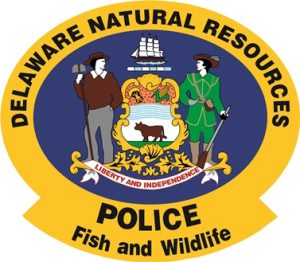Reminder for the week: Recreational boaters need to watch out for gillnets in bay, river
 DOVER – To achieve public compliance through education and enforcement actions that help conserve Delaware’s fish and wildlife resources and ensure safe boating and public safety, DNREC Division of Fish & Wildlife Natural Resources Police officers between Feb. 1-7 made 797 contacts with anglers, boaters, hunters and the general public, including 16 vessel boardings for boating safety and fishing regulation compliance checks. Officers responded to 23 complaints and issued 16 citations. This week, with an expanded Fish & Wildlife Natural Resources Police presence continuing to be deployed as a deterrent, no citations were issued at the C&D Canal Conservation Area and associated recreational trail.
DOVER – To achieve public compliance through education and enforcement actions that help conserve Delaware’s fish and wildlife resources and ensure safe boating and public safety, DNREC Division of Fish & Wildlife Natural Resources Police officers between Feb. 1-7 made 797 contacts with anglers, boaters, hunters and the general public, including 16 vessel boardings for boating safety and fishing regulation compliance checks. Officers responded to 23 complaints and issued 16 citations. This week, with an expanded Fish & Wildlife Natural Resources Police presence continuing to be deployed as a deterrent, no citations were issued at the C&D Canal Conservation Area and associated recreational trail.
An item of particular note:
- On Feb. 7, Fish & Wildlife Natural Resources Police arrested Matthew D. Hoffman, 18, of Smyrna, and charged him with one count each of failure to tag antlerless deer, failure to retain tag on antlerless deer, failure to register antlerless deer within 24 hours and butchering antlerless deer prior to registration near Little Creek. Hoffman was taken to Justice of the Peace Court 7 in Dover, where he pled guilty to the charges. He was fined a total of $358, including court costs.
Citations issued this week by offense category included the following, with the number of charges in parentheses:
Wildlife Conservation: Trespassing after hours on a state wildlife area (9), failure to tag antlerless deer (1), failure to retain tag on antlerless deer (1), failure to register antlerless deer within 24 hours (1), and butchering antlerless deer prior to registration (1).
Fisheries Conservation: Unlicensed fishing (1).
Public Safety: Loitering (2).
Fish & Wildlife Natural Resources Police News, Training and Outreach
On Feb. 7, Sussex County Fish & Wildlife Natural Resources Police officers attended the 25th annual Lewes Polar Bear Plunge with two patrol vessels to monitor safety. No incidents were reported during the event, which drew more than 3,500 plungers and raised a record $820,000 for Special Olympics Delaware.
Are you AWARE?
DNREC’s Division of Fish & Wildlife Natural Resources Police remind recreational anglers that Monday, Feb. 15 is the opening day of commercial striped bass fixed gillnet season on the Delaware Bay and portions of the Delaware River.
So what is a fixed gillnet, can recreational anglers and boaters expect to encounter them when fishing and what do they need to be aware of when navigating around these nets? “A commercial fixed gillnet is an upright net or fence made of fiber or monofilament measuring up to 200 yards in length and attached to a single pole on each end. These nets are designed to catch fish by their gills,” said Sgt. John McDerby, Fish & Wildlife Natural Resources Police. “To help ensure the safety of other vessels, the location of fixed gillnets must be well-marked for visibility from the water’s surface.”
Delaware law requires commercial watermen to mark gillnets in the Delaware Bay and portions of the Delaware River as follows:
- A red or international orange flag measuring 12 inches by 12 inches must be placed on each of the net’s two end poles from April 1 through Nov. 30.
- Red or international orange floats measuring a minimum of 8 inches in diameter may be substituted on the end poles from Dec. 1 through March 31.
- Each of these flags or floats must be marked with the commercial waterman’s assigned license number.
- Flags or floats must include a minimum of 24 square inches of reflective material in order to be visible for nighttime navigation.
- White floats measuring 4 inches in diameter must be placed along the net inside each of the required red or international orange flags or floats, beginning within 20 feet of each end pole.
“Even with these marking requirements, gillnets are not always easy to spot, especially at night and during adverse weather conditions,” said Sgt. McDerby. “Boaters and anglers need to be aware of the size of these nets. If they are set in a series with shared rigging, they can be up to 500 yards long – and they are not necessarily placed in a straight line. Because of the length of the nets and their abundance in the Delaware Bay and River during striped bass season, navigation can be challenging, even for a seasoned boater.”
All boaters should slow down and use caution when operating in areas where nets have been set, McDerby added. Slowing down will help make navigation much less challenging and decrease the risk of crossing the nets and a potential accident.
For more information on safe boating practices, click Delaware Boating Safety.
DNREC’s Division of Fish & Wildlife recognizes and thanks the majority of anglers, hunters and boaters who comply with and support Delaware’s fishing, hunting and boating laws and regulations. Citizens are encouraged to report fish, wildlife and boating violations to the Delaware Fish & Wildlife Natural Resources Police by calling 302-739-4580. Wildlife violations may also be reported anonymously to Operation Game Theft by calling 800-292-3030 or online at http://de.gov/ogt.
Media Contacts: Sgt. John McDerby, Fish & Wildlife Natural Resources Police, 302-739-9913 or 302-354-1386, or Joanna Wilson, DNREC Public Affairs, 302-739-9902
Vol. 46, No. 38